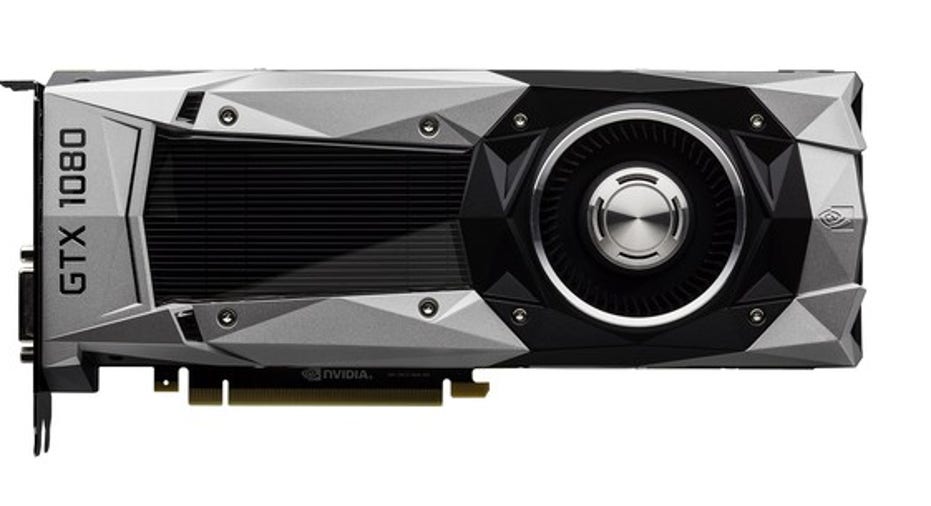NVIDIA Corporation GeForce GTX 1080 Ti Specs Leak

Image source: NVIDIA.
Earlier this year, graphics specialist NVIDIA (NASDAQ: NVDA) released a suite of new graphics processors targeted at gaming personal computers based on its new Pascal architecture. The products that have launched so far have provided substantial boosts in performance and power efficiency relative to their predecessors.
So far, NVIDIA has released direct successors to the Maxwell-architecture-based GeForce GTX 960, GeForce GTX 970, GeForce GTX 980, and GeForce GTX Titan X. However, it has yet to formally announce the successor to the GeForce GTX 980 Ti.
However, thanks to a leak from website Overclock3D, we now know what NVIDIA is planning to bring to the table with the GeForce GTX 1080 Ti -- the successor to the 980 Ti.
As expected, it's a cut-down Titan X
Back in July, NVIDIA introduced the Titan X to replace the prior-generation GeForce GTX Titan X (confusing naming, I know). The Titan X is based on a partially disabled version of a chip known as GP102 (3,584 out of the 3,840 graphics processing cores on the chip were enabled) running at a base frequency of 1417 MHz and a boost frequency of 1531 MHz. It also packed 12 gigabytes of high-performance GDDR5X memory.
According to the leak, the GTX 1080 Ti will come with 3,328 graphics cores enabled, running at a base frequency of 1503 MHz and a boost frequency of 1623 MHz -- a fair bit higher than what the Titan X runs at. The 1080 Ti is still expected to include 12 gigabytes of memory, but instead of faster GDDR5X memory, it will use cheaper and slower GDDR5 memory.
In terms of gaming performance, I would expect that the higher clock speeds will allow NVIDIA (and its add-in-board partners) to deliver something quite close to NVIDIA's $1,200 Titan X at much more accessible price points.
When will we see it?
The leak doesn't mention a particular launch window or time frame, but timing the launch of this product could be quite tricky for NVIDIA and its add-in-board partners. On one hand, NVIDIA and its partners should aim to strike while the iron is hot; getting this chip out within the next couple of months will mean that NVIDIA and its board partners should be able to enjoy robust average selling prices (ASPs).
Indeed, the GTX 1080 is advertised at an MSRP of $599 with actual street prices ranging from around $610 to north of $700, depending on a number of factors (such as the quality of the board, the cooling solution used, the speed that it runs at out of the box, and so on).
I can easily see the GTX 1080 Ti selling at an MSRP in the range of $699 to $799, with higher-end custom models coming in at even higher price points. Such pricing would allow NVIDIA and its partners to continue to successfully sell the GTX 1080 while at the same time offering potential customers a choice to buy something with more performance at a higher price point (assuming those customers don't find the $1,200 Titan X a particularly appealing option).
As far as timing goes, I wouldn't be surprised to see the 1080 Ti hit the shelves in the October/November time frame. Remember that back in 2013, NVIDIA released the GeForce GTX 780 in May and then followed it up with the GeForce GTX 780 Ti in November. Getting the 1080 Ti in the November time frame this year, especially with a number of demanding new game titles launching around that time (Battlefield 1 is coming on Oct. 21 and Call of Duty: Infinite Warfare will be released on Nov. 4), could work out nicely for the graphics chip specialist.
Potential business impact
The launch of the GTX 1080 Ti should give NVIDIA the opportunity to improve its blended ASPs, since there are likely to be several potential GTX 1080 buyers who stretch their budgets to get the higher-end GTX 1080 Ti instead.
On the other hand, there may be some potential Titan X buyers who ultimately choose to go with the 1080 Ti, but intuitively I'd expect that when all is said and done, ASPs -- and ultimately, revenue -- will go up.
A secret billion-dollar stock opportunity The world's biggest tech company forgot to show you something, but a few Wall Street analysts and the Fool didn't miss a beat: There's a small company that's powering their brand-new gadgets and the coming revolution in technology. And we think its stock price has nearly unlimited room to run for early in-the-know investors! To be one of them, just click here.
Ashraf Eassa has no position in any stocks mentioned. The Motley Fool owns shares of and recommends NVIDIA. Try any of our Foolish newsletter services free for 30 days. We Fools may not all hold the same opinions, but we all believe that considering a diverse range of insights makes us better investors. The Motley Fool has a disclosure policy.



















